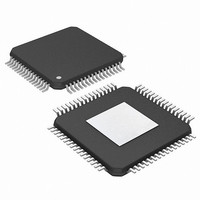PIC24FJ256DA206-I/MR Microchip Technology, PIC24FJ256DA206-I/MR Datasheet - Page 344

PIC24FJ256DA206-I/MR
Manufacturer Part Number
PIC24FJ256DA206-I/MR
Description
MCU PIC 16BIT FLASH 256K 64VQFN
Manufacturer
Microchip Technology
Series
PIC® 24Fr
Specifications of PIC24FJ256DA206-I/MR
Program Memory Type
FLASH
Program Memory Size
256KB (85.5K x 24)
Package / Case
64-VFQFN, Exposed Pad
Core Processor
PIC
Core Size
16-Bit
Speed
32MHz
Connectivity
I²C, IrDA, SPI, UART/USART, USB OTG
Peripherals
Brown-out Detect/Reset, GFX, LVD, POR, PWM, WDT
Number Of I /o
52
Ram Size
96K x 8
Voltage - Supply (vcc/vdd)
2.2 V ~ 3.6 V
Data Converters
A/D 16x10b
Oscillator Type
Internal
Operating Temperature
-40°C ~ 85°C
Processor Series
PIC24FJ
Core
PIC
Data Bus Width
16 bit
Data Ram Size
96 KB
Interface Type
UART, SPI, USB, I2C, RS-485, RS-232
Maximum Clock Frequency
32 MHz
Number Of Programmable I/os
23
Number Of Timers
5
Operating Supply Voltage
3.6 V
Maximum Operating Temperature
+ 85 C
Mounting Style
SMD/SMT
3rd Party Development Tools
52713-733, 52714-737, 53276-922, EWDSPIC
Development Tools By Supplier
PG164130, DV164035, DV244005, DV164005, AC164127-4, AC164127-6, AC164139, DM240001, DM240312, DV164039
Minimum Operating Temperature
- 40 C
Lead Free Status / RoHS Status
Lead free / RoHS Compliant
Eeprom Size
-
Lead Free Status / Rohs Status
Lead free / RoHS Compliant
- Current page: 344 of 408
- Download datasheet (4Mb)
modules are related in this application. This example
PIC24FJ256DA210 FAMILY
26.2
Time measurements on the pulse width can be similarly
performed using the A/D module’s internal capacitor
(C
Figure 26-2 shows the external connections used for
time measurements, and how the CTMU and A/D
also shows both edge events coming from the external
CTEDG pins, but other configurations using internal
edge sources are possible. A detailed discussion on
measuring capacitance and time with the CTMU module
is provided in the “PIC24F Family Reference Manual”.
26.3
The CTMU module can also generate an output pulse
with edges that are not synchronous with the device’s
system clock. More specifically, it can generate a pulse
with a programmable delay from an edge event input to
the module.
FIGURE 26-2:
FIGURE 26-3:
DS39969B-page 344
AD
) and a precision resistor for current calibration.
Measuring Time
Pulse Generation and Delay
TYPICAL CONNECTIONS AND INTERNAL CONFIGURATION FOR TIME
MEASUREMENT TIME
TYPICAL CONNECTIONS AND INTERNAL CONFIGURATION FOR PULSE
DELAY GENERATION
CTEDG1
C2INB
C
DELAY
CTEDG1
CTEDG2
ANx
R
PR
EDG1
CV
Current Source
PIC24F Device
Comparator
REF
CTMU
C2
EDG2
EDG1
C
AD
PIC24F Device
When the module is configured for pulse generation
delay by setting the TGEN (CTMUCON<12>) bit, the
internal current source is connected to the B input of
Comparator 2. A capacitor (C
the Comparator 2 pin, C2INB, and the comparator volt-
age reference, CV
is then configured for a specific trip point. The module
begins to charge C
detected. When C
point, a pulse is output on CTPLS. The length of the
pulse delay is determined by the value of C
the CV
Figure 26-3 shows the external connections for pulse
generation, as well as the relationship of the different
analog modules required. While CTEDG1 is shown as
the input pulse source, other options are available. A
detailed discussion on pulse generation with the CTMU
module is provided in the “PIC24F Family Reference
Manual”.
A/D Converter
Current Source
CTMU
REF
Output Pulse
trip point.
DELAY
REF
DELAY
CTPLS
, is connected to C2INA. CV
2010 Microchip Technology Inc.
charges above the CV
when an edge event is
DELAY
) is connected to
DELAY
REF
and
REF
trip
Related parts for PIC24FJ256DA206-I/MR
Image
Part Number
Description
Manufacturer
Datasheet
Request
R

Part Number:
Description:
Manufacturer:
Microchip Technology Inc.
Datasheet:

Part Number:
Description:
Manufacturer:
Microchip Technology Inc.
Datasheet:

Part Number:
Description:
Manufacturer:
Microchip Technology Inc.
Datasheet:

Part Number:
Description:
Manufacturer:
Microchip Technology Inc.
Datasheet:

Part Number:
Description:
Manufacturer:
Microchip Technology Inc.
Datasheet:

Part Number:
Description:
Manufacturer:
Microchip Technology Inc.
Datasheet:

Part Number:
Description:
Manufacturer:
Microchip Technology Inc.
Datasheet:

Part Number:
Description:
Manufacturer:
Microchip Technology Inc.
Datasheet:










